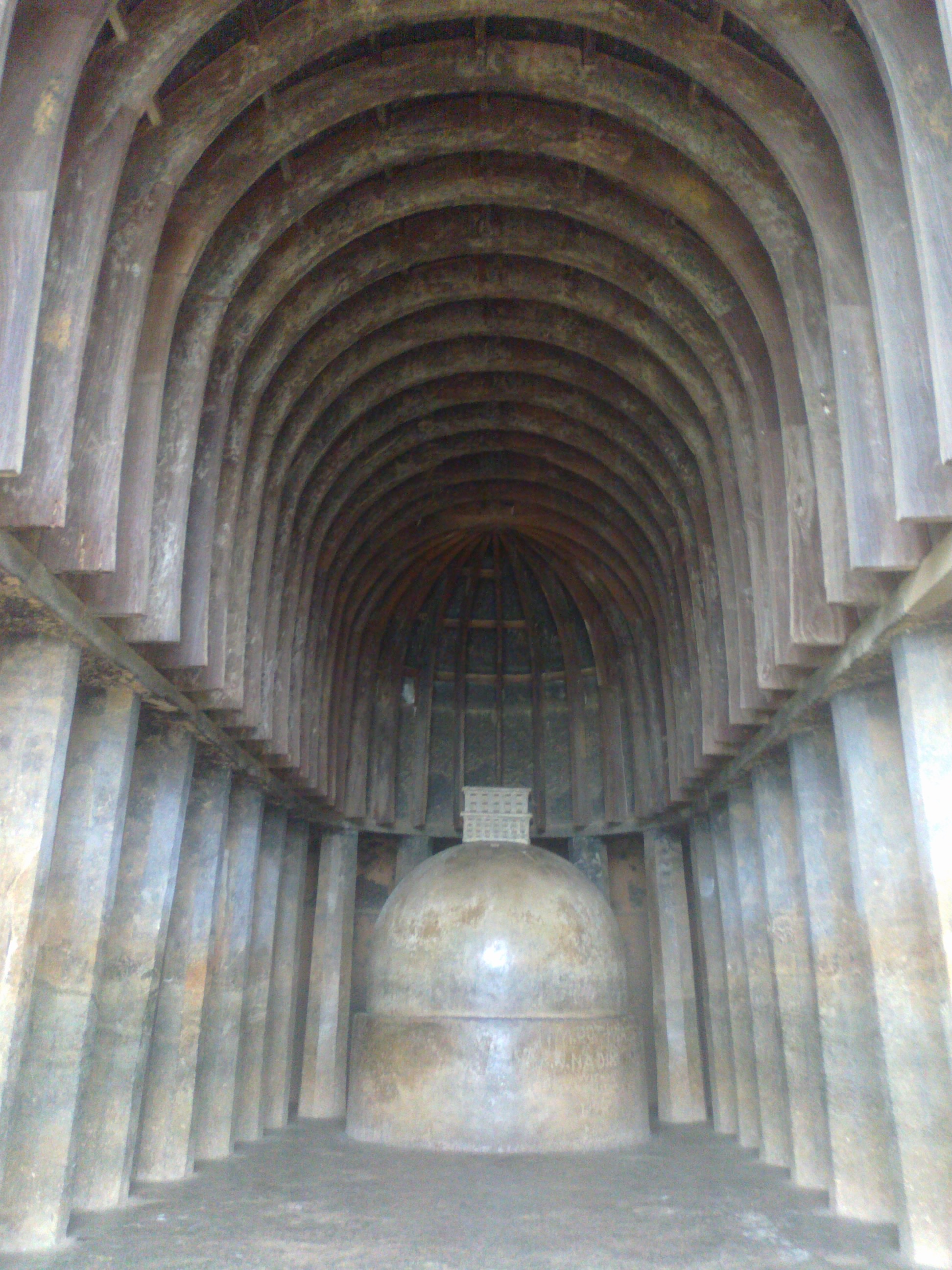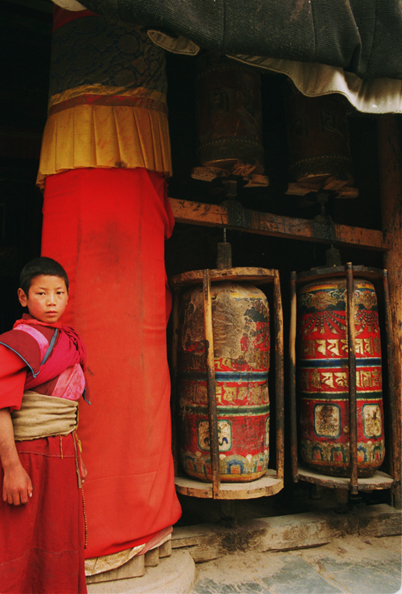|
Parikrama
Parikrama or Pradakshina is clockwise circumambulation of sacred entities, and the path along which this is performed, as practiced in the Indic religions - Hinduism, Buddhism, Sikhism and Jainism. In Buddhism, it refers only to the path along which this is performed. Typically, in Indic-religions the parikrama is done after completion of traditional worship ( puja) and after paying homage to the deity. Parikrama must be done with dhyāna (spiritual contemplation and meditation). In Hinduism, parikarma of religious deities in a temple, sacred rivers, sacred hills and a close cluster of temples as a symbol of prayer is an integral part of Hindu worship.http://www.hindunet.org/faq/fom-serv/cache/31.html Why do we perform Pradakshina or Parikrama?http://www.hinduism.co.za/kaabaa.htm Kaaba a Hindu Temple?Hindus invariably circumambulate around their deities Hindu temple architecture include various Pradakshina paths. There could a parikarma path surrounding the chief deity, an ... [...More Info...] [...Related Items...] OR: [Wikipedia] [Google] [Baidu] |
Parikrama
Parikrama or Pradakshina is clockwise circumambulation of sacred entities, and the path along which this is performed, as practiced in the Indic religions - Hinduism, Buddhism, Sikhism and Jainism. In Buddhism, it refers only to the path along which this is performed. Typically, in Indic-religions the parikrama is done after completion of traditional worship ( puja) and after paying homage to the deity. Parikrama must be done with dhyāna (spiritual contemplation and meditation). In Hinduism, parikarma of religious deities in a temple, sacred rivers, sacred hills and a close cluster of temples as a symbol of prayer is an integral part of Hindu worship.http://www.hindunet.org/faq/fom-serv/cache/31.html Why do we perform Pradakshina or Parikrama?http://www.hinduism.co.za/kaabaa.htm Kaaba a Hindu Temple?Hindus invariably circumambulate around their deities Hindu temple architecture include various Pradakshina paths. There could a parikarma path surrounding the chief deity, an ... [...More Info...] [...Related Items...] OR: [Wikipedia] [Google] [Baidu] |
Yatra
( sa, यात्रा, 'journey', 'procession'), in Indian-origin religions, Hinduism, Buddhism, Jainism and Sikhism, generally means a pilgrimage to holy places such as confluences of sacred rivers, sacred mountains, places associated with Hindu epics such as the Mahabharata and Ramayana, and other sacred pilgrimage sites. Visiting a sacred place is believed by the pilgrim to purify the self and bring one closer to the divine. The journey itself is as important as the destination, and the hardships of travel serve as an act of devotion in themselves. A is a pilgrimage to a sacred site, generally undertaken in groups. Yatri is the term for anyone who undertakes the yatra. According to Vedic Hindu Dharma Shastras, a Yatri ought to perform Yatra on foot, called padayatra, ideally barefoot as a form of tapasya in which the pilgrim should travel without umbrellas or vehicles; however, many yatris do not follow these niyamas. In present times, yatras are highly organized a ... [...More Info...] [...Related Items...] OR: [Wikipedia] [Google] [Baidu] |
Circumambulation
Circumambulation (from Latin ''circum'' around and ''ambulātus ''to walk) is the act of moving around a sacred object or idol. Circumambulation of temples or deity images is an integral part of Hindu and Buddhist devotional practice (known in Sanskrit as '' pradakśiṇā''). It is also present in other religions, including Christianity, Judaism, and Islam. Hinduism In many Hindu temples, the temple structure reflects the symbolism of the Hindu association of the spiritual transition from daily life to spiritual perfection as a journey through stages. Passageways for circumambulation are present through which worshipers move in a clockwise direction, starting at the sanctuary doorway and moving inward toward the inner sanctum where the deity is enshrined. This is a translation of the spiritual concept of transition through levels in life into bodily movements by the worshipers as they move inwardly through ambulatory halls to the most sacred centre of spiritual energy of the d ... [...More Info...] [...Related Items...] OR: [Wikipedia] [Google] [Baidu] |
Chaitya
A chaitya, chaitya hall, chaitya-griha, (Sanskrit:''Caitya''; Pāli: ''Cetiya'') refers to a shrine, sanctuary, temple or prayer hall in Indian religions. The term is most common in Buddhism, where it refers to a space with a stupa and a rounded apse at the end opposite the entrance, and a high roof with a rounded profile. Strictly speaking, the chaitya is the stupa itself, and the Indian buildings are chaitya halls, but this distinction is often not observed. Outside India, the term is used by Buddhists for local styles of small stupa-like monuments in Nepal, Cambodia, Indonesia and elsewhere. In Thailand a stupa, not a stupa hall, is called a chedi. In the historical texts of Jainism and Hinduism, including those relating to architecture, ''chaitya'' refers to a temple, sanctuary or any sacred monument. Most early examples of chaitya that survive are Indian rock-cut architecture. Scholars agree that the standard form follows a tradition of free-standing halls made of wood and o ... [...More Info...] [...Related Items...] OR: [Wikipedia] [Google] [Baidu] |
Mount Kailash
Mount Kailash (also Kailasa; ''Kangrinboqê'' or ''Gang Rinpoche''; Standard Tibetan, Tibetan: གངས་རིན་པོ་ཆེ; ; sa, कैलास, ), is a mountain in the Ngari Prefecture, Tibet Autonomous Region of China. It has an altitude of . It lies in the Gangdise Shan, Kailash Range (Gangdisê Mountains) of the Transhimalaya, in the western part of the Tibetan Plateau. Mount Kailash is less than 100 km towards the north from the western trijunction of the borders of China, India, and Nepal. Mount Kailash is located close to Lake Manasarovar and Lake Rakshastal. The sources of four major Asian rivers lie close to this mountain and the two lakes. These rivers are the Indus River, Indus, the Sutlej, the Brahmaputra River, Brahmaputra, and the Karnali River, Karnali (a tributary of the Ganges). Mount Kailash is considered sacred in four religions: Hinduism, Buddhism, Jainism and Bon. Etymology The mountain is known as “'” (; var. ' ) in Sanskrit. The nam ... [...More Info...] [...Related Items...] OR: [Wikipedia] [Google] [Baidu] |
Hindu Temple Architecture
Hindu temple architecture as the main form of Hindu architecture has many varieties of style, though the basic nature of the Hindu temple remains the same, with the essential feature an inner sanctum, the ''garbha griha'' or womb-chamber, where the primary ''Murti'' or the image of a deity is housed in a simple bare cell. This chamber often has an open area designed for movement in clockwise rotation for rituals and prayers. Around this chamber there are often other structures and buildings, in the largest cases covering several acres. On the exterior, the garbhagriha is crowned by a tower-like ''shikhara'', also called the ''vimana'' in the south. The shrine building often includes an circumambulatory passage for parikrama, a mandapa congregation hall, and sometimes an antarala antechamber and porch between garbhagriha and mandapa. There may be other mandapas or other buildings, connected or detached, in large temples, together with other small temples in the compound. Hindu ... [...More Info...] [...Related Items...] OR: [Wikipedia] [Google] [Baidu] |
Hindu Wedding
A Hindu wedding, also known as Vivaha (Devanagari: विवाह; Kannada script: ವಿವಾಹ; ''Vivaaha'') (), Lagna (लग्न), or Kalyanam (Devanagari: कल्याणम्; Kannada script: ಕಲ್ಯಾಣಮ್; ta, கல்யாணம்), is the traditional wedding ceremony for Hindus. The wedding ceremonies are very colourful, and celebrations may extend for several days. The bride's and groom's home—entrance, doors, wall, floor, roof—are sometimes decorated with colors, flowers, and other decorations.Yee, A. (2008 May 17Sari nights and henna parties ''The Financial Times''. The word ''vivāha'' originated as a sacred union of people as per Vedic traditions, i.e. what many call marriage, but based on cosmic laws and advanced ancient practices. Under Vedic Hindu traditions, marriage is viewed as one of the saṁskāras, which are lifelong commitments of one wife and one husband. In India, marriage has been looked upon as having been designed by the ... [...More Info...] [...Related Items...] OR: [Wikipedia] [Google] [Baidu] |
Labrang03
Labrang Monastery (; Chinese: Lāboléng Sì, 拉卜楞寺) is one of the six great monasteries of the Gelug school of Tibetan Buddhism. Its formal name is ''Genden Shédrup Dargyé Trashi Gyésu khyilwé Ling'' (). Labrang is located in Xiahe County, Gannan Tibetan Autonomous Prefecture, Gansu, in the traditional Tibetan area of Amdo. Labrang Monastery is home to the largest number of monks outside the Tibet Autonomous Region. Xiahe is about four hours by car from the provincial capital Lanzhou. In the early part of the 20th century, Labrang was by far the largest and most influential monastery in Amdo. It is located on the Daxia River, a tributary of the Yellow River. History The monastery was founded in 1709 by the first Jamyang Zhépa, Ngawang Tsöndrü. It is one of Tibetan Buddhism's most important monastery town outside the Tibetan Autonomous Region. Labrang Monastery is situated at the strategic intersection of two major Asian cultures—Tibetan and Mongolian — a ... [...More Info...] [...Related Items...] OR: [Wikipedia] [Google] [Baidu] |
Stupa
A stupa ( sa, स्तूप, lit=heap, ) is a mound-like or hemispherical structure containing relics (such as ''śarīra'' – typically the remains of Buddhist monks or nuns) that is used as a place of meditation. In Buddhism, circumambulation or ''pradakhshina'' has been an important ritual and devotional practice since the earliest times, and stupas always have a ''pradakhshina'' path around them. The original South Asian form is a large solid dome above a tholobate or drum with vertical sides, which usually sits on a square base. There is no access to the inside of the structure. In large stupas there may be walkways for circumambulation on top of the base as well as on the ground below it. Large stupas have or had ''vedikā'' railings outside the path around the base, often highly decorated with sculpture, especially at the torana gateways, of which there are usually four. At the top of the dome is a thin vertical element, with one of more horizontal discs spreadin ... [...More Info...] [...Related Items...] OR: [Wikipedia] [Google] [Baidu] |
Plan Of Kandariya Mahadeva Temple
A plan is typically any diagram or list of steps with details of timing and resources, used to achieve an objective to do something. It is commonly understood as a temporal set of intended actions through which one expects to achieve a goal. For spatial or planar topologic or topographic sets see map. Plans can be formal or informal: * Structured and formal plans, used by multiple people, are more likely to occur in projects, diplomacy, careers, economic development, military campaigns, combat, sports, games, or in the conduct of other business. In most cases, the absence of a well-laid plan can have adverse effects: for example, a non-robust project plan can cost the organization time and money. * Informal or ad hoc plans are created by individuals in all of their pursuits. The most popular ways to describe plans are by their breadth, time frame, and specificity; however, these planning classifications are not independent of one another. For instance, there is a close ... [...More Info...] [...Related Items...] OR: [Wikipedia] [Google] [Baidu] |
Indian Rock-cut Architecture
Indian rock-cut architecture is more various and found in greater abundance in that country than any other form of rock-cut architecture around the world. Rock-cut architecture is the practice of creating a structure by carving it out of solid natural rock. Rock that is not part of the structure is removed until the only rock left makes up the architectural elements of the excavated interior. Indian rock-cut architecture is mostly religious in nature. There are more than 1,500 known rock-cut structures in India. Many of these structures contain artwork of global importance, and most are adorned with exquisite stone carvings. These ancient and medieval structures represent significant achievements of structural engineering and craftsmanship. The effort expended often astonishes visitors, but seen from one aspect, a rock-cut structure is a decorated rock quarry; most of the stone removed was typically put to economic use elsewhere. In India, caves have long been regarded as sacr ... [...More Info...] [...Related Items...] OR: [Wikipedia] [Google] [Baidu] |









